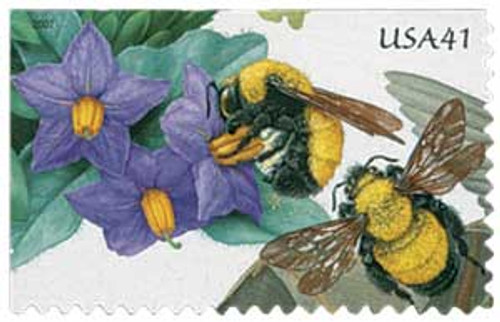
2007 41c Pollination: Bat and Saguaro
# 4155 - 2007 41c Pollination: Bat and Saguaro
$0.45 - $3.75
U.S. #4155
2007 41¢ Bat
Pollination
2007 41¢ Bat
Pollination
Issue Date: June 29, 2007
City: Washington, DC
Quantity: 420,000,000
City: Washington, DC
Quantity: 420,000,000
Printed By: Ashton-Potter (USA) Ltd
Printing Method: Lithographed
Perforations: Serpentine die cut 11
Color: Multicolored
One third of the world's food supply requires insect pollination, and 80% of those crops are pollinated by bees. Pollination occurs as bees visit flowers for nourishment, eating nectar for energy and pollen for protein. Pollen sticks to the bees' leg hairs and is brushed off as the bees move from flower to flower, fertilizing the plants.
Bats eat nectar, pollen, fruit, and insects while pollinating fragrant night-opening flowers. They are especially drawn to white, cream, and green flowers. Over 300 types of fruit, including mangoes, bananas, and guavas depend on bats for pollination. Some tropical plants are entirely dependent on bats to spread their seeds or pollinate.
U.S. #4155
2007 41¢ Bat
Pollination
2007 41¢ Bat
Pollination
Issue Date: June 29, 2007
City: Washington, DC
Quantity: 420,000,000
City: Washington, DC
Quantity: 420,000,000
Printed By: Ashton-Potter (USA) Ltd
Printing Method: Lithographed
Perforations: Serpentine die cut 11
Color: Multicolored
One third of the world's food supply requires insect pollination, and 80% of those crops are pollinated by bees. Pollination occurs as bees visit flowers for nourishment, eating nectar for energy and pollen for protein. Pollen sticks to the bees' leg hairs and is brushed off as the bees move from flower to flower, fertilizing the plants.
Bats eat nectar, pollen, fruit, and insects while pollinating fragrant night-opening flowers. They are especially drawn to white, cream, and green flowers. Over 300 types of fruit, including mangoes, bananas, and guavas depend on bats for pollination. Some tropical plants are entirely dependent on bats to spread their seeds or pollinate.










